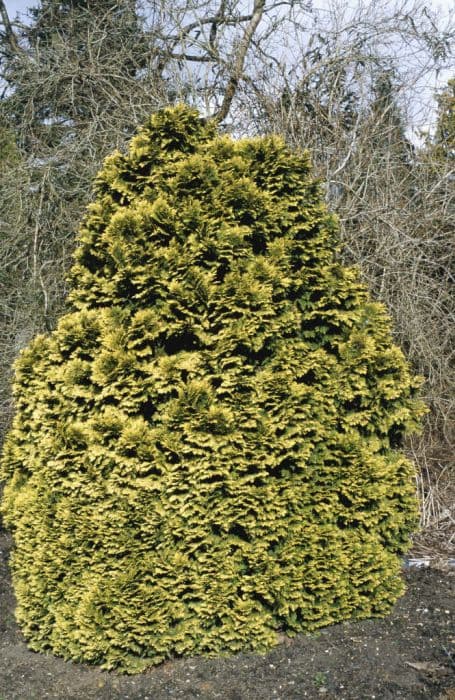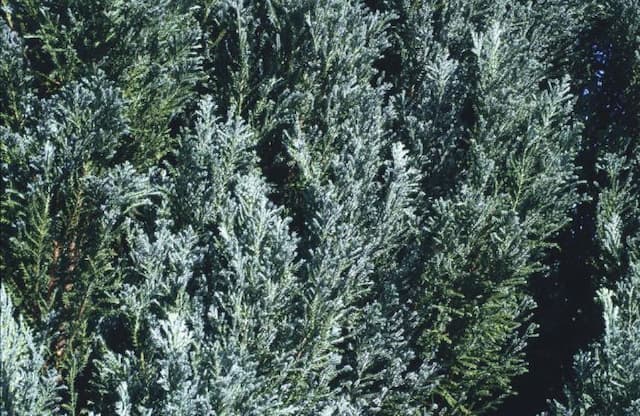Flaky juniper 'Holger' Juniperus squamata 'Holger'

ABOUT
'Holger' is a bushy evergreen conifer of irregular outline, forming a medium-sized shrub with creamy-yellow new growth which becomes blue-grey with maturity
About this plant
 Names
NamesFamily
Cupressaceae
Synonyms
Holger Juniper, Flaky Juniper 'Holger'
Common names
Juniperus squamata 'Holger'.
 Characteristics
CharacteristicsLife cycle
Perennials
Foliage type
Evergreen
Color of leaves
Blue-green
Height
2 feet (0.61 meters)
Spread
4 feet (1.22 meters)
Plant type
Shrub
Hardiness zones
4-8
Native area
Asia
Benefits
 General Benefits
General Benefits- Low Maintenance: Holger Juniper is drought tolerant once established, requiring minimal watering and care.
- Landscape Design: With its unique silver-blue foliage and yellow new growth, it adds color contrast and visual interest to gardens.
- Erosion Control: The plant's extensive root system helps stabilize slopes and prevent soil erosion.
- Wildlife Habitat: Provides shelter and nesting sites for birds and other small wildlife.
- Year-Round Interest: Evergreen nature ensures that it provides visual interest in all seasons.
- Disease Resistance: Generally resistant to many common plant diseases, reducing the need for chemical treatments.
- Tolerance: Capable of surviving in a broad range of soils and can tolerate urban conditions like salt and pollution.
- Growth Habit: Its compact and spreading habit is ideal for ground cover, rock gardens, and as a foundation plant.
 Medical Properties
Medical PropertiesThis plant is not used for medical purposes.
 Air-purifying Qualities
Air-purifying QualitiesThis plant is not specifically known for air purifying qualities.
 Other Uses
Other Uses- Juniper aroma: The foliage of Holger juniper can be used in potpourri for its distinct resinous aroma that can freshen up a room.
- Bonsai creation: With its attractive foliage and adaptability to pruning, Holger juniper can be trained as a bonsai for ornamental purposes.
- Wildlife habitat: Dense branches provide shelter and nesting spots for birds and other small wildlife when used in landscaping.
- Windbreaks: Holger juniper can be planted in rows to act as a windbreak, protecting more sensitive plants and reducing soil erosion.
- Erosion control: The plant's root system helps stabilize slopes and prevent soil erosion in both domestic and wild landscapes.
- Garden sculpture: The flexible branches and foliage can be trimmed and shaped into topiaries or other artistic garden sculptures.
- Privacy screening: Holger juniper can be grown to form a natural privacy screen due to its dense growth habit.
- Soil improvement: As plant material falls and decomposes, it can contribute to soil fertility and improve its structure.
- Theme gardening: Holger juniper can fit into a 'blue' themed garden due to the hue of its needles.
- Cooking smoke: While not conventional, small branches or needles can be used to add a juniper-flavored smoke when barbecuing meats, similar to using wood chips.
Interesting Facts
 Feng Shui
Feng ShuiThe Juniper is not used in Feng Shui practice.
 Zodiac Sign Compitability
Zodiac Sign CompitabilityThe Juniper is not used in astrology practice.
 Plant Symbolism
Plant Symbolism- Protection: Junipers are traditionally associated with safeguarding against negative forces and energies, often used to ward off evil spirits.
- Purity: The clean and sharp scent of juniper is said to purify the air and environment, leading to its use in rituals and cleansing practices.
- Healing: Juniper is known for its medicinal properties and has been used in various cultures for its ability to aid in healing and health restoration.
- Endurance: The hardy nature of juniper plants, thriving in harsh conditions, symbolizes endurance and the ability to persist through difficulties.
 Water
WaterThe Blue Star Juniper should be watered deeply but infrequently, with the soil being allowed to dry out between waterings. Generally, a good rule of thumb is to provide about 1 to 2 gallons of water every two weeks, adjusting for rainfall and temperatures. During the hotter summer months, water needs may increase and it might be necessary to water weekly. In the winter, reduce the frequency to once a month or less, as the plant will require less water during dormancy. Be sure to water at the base of the plant to avoid wetting the foliage.
 Light
LightThe Blue Star Juniper thrives in full sun conditions. It prefers to receive at least 6 hours of direct sunlight daily, making an unobstructed south or west-facing location ideal. If the plant does not receive enough light, it might not grow as vigorously or maintain its dense, blue-green foliage.
 Temperature
TemperatureThe Blue Star Juniper is hardy and can withstand a range of temperatures, tolerating cold down to -30 degrees Fahrenheit and heat up to 90 degrees Fahrenheit. However, it thrives in temperatures between 60 to 75 degrees Fahrenheit. It is important to note that extreme heat may require additional watering, and proper mulching can help the roots stay cool.
 Pruning
PruningThe Blue Star Juniper should be pruned to maintain its shape and to remove any dead or damaged branches. The best time to prune is in the late winter or early spring before new growth starts. It's generally recommended to prune this plant lightly and not too often, possibly once a year, to maintain its natural form and dense foliage.
 Cleaning
CleaningNot needed
 Soil
SoilThe Flaky Juniper 'Holger' thrives in well-draining soil, a mix of sand, clay, and organic matter like peat moss being ideal. Aim for a soil pH between 5.5 to 7.0 for optimal growth.
 Repotting
RepottingFlaky Juniper 'Holger' typically needs repotting every 2 to 3 years to refresh the soil and encourage growth, but less frequently as it matures.
 Humidity & Misting
Humidity & MistingFlaky Juniper 'Holger' prefers a low to moderate humidity environment, typical of outdoor conditions, not requiring high humidity levels.
 Suitable locations
Suitable locationsIndoor
Ensure bright light, cool temps, and good airflow for Flaky Juniper.
Outdoor
Plant in full sun, well-draining soil; tolerate cold, drought.
Hardiness zone
4-8 USDA
 Life cycle
Life cycleJuniperus squamata 'Holger', commonly known as Holger Juniper, begins its life cycle as a seed, typically requiring stratification to break dormancy and germinate. Upon germination, it develops into a seedling with juvenile foliage, marked by a blue-green color. As the plant matures, its characteristic scale-like adult foliage emerges, often accompanied by a striking creamy-yellow new growth at the tips, giving it a distinctive appearance. Holger Juniper reaches reproductive maturity after several years, producing small, blue berry-like cones that contain the seeds for the next generation. This slow-growing conifer continues to increase in size and spread, often reaching a mature height of 1-1.5 meters and a spread of 1.5-2 meters. The Holger Juniper is long-lived, with a life span that can exceed multiple decades under suitable growing conditions.
 Propogation
PropogationPropogation time
Spring-Early Summer
Juniperus squamata 'Holger', commonly known as Holger Juniper, is most commonly propagated through softwood cuttings. This technique involves taking cuttings from new growth in late spring or early summer when the wood is still green and flexible. Typically, cuttings about 4 to 6 inches (10 to 15 centimeters) long are snipped just below a node. The lower needles are removed, and the cut end is often dipped in a rooting hormone to encourage root development. The prepared cutting is then placed in a well-draining rooting medium, such as a mix of peat and perlite. The cuttings are kept under high humidity and indirect light until roots have developed, which can take several weeks to a few months. After rooting, the cuttings can be potted up individually and eventually planted out.









